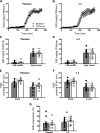Effects of Dietary n-3 Fatty Acids on Hepatic and Peripheral Insulin Sensitivity in Insulin-Resistant Humans
- PMID: 25852206
- PMCID: PMC4477338
- DOI: 10.2337/dc14-3101
Effects of Dietary n-3 Fatty Acids on Hepatic and Peripheral Insulin Sensitivity in Insulin-Resistant Humans
Abstract
Objective: Dietary n-3 polyunsaturated fatty acids, including eicosapentaenoic acid (EPA) and docosahexaenoic acid (DHA), prevent insulin resistance and stimulate mitochondrial biogenesis in rodents, but the findings of translational studies in humans are thus far ambiguous. The aim of this study was to evaluate the influence of EPA and DHA on insulin sensitivity, insulin secretion, and muscle mitochondrial function in insulin-resistant, nondiabetic humans using a robust study design and gold-standard measurements.
Research design and methods: Thirty-one insulin-resistant adults received 3.9 g/day EPA+DHA or placebo for 6 months in a randomized double-blind study. Hyperinsulinemic-euglycemic clamp with somatostatin was used to assess hepatic and peripheral insulin sensitivity. Postprandial glucose disposal and insulin secretion were measured after a meal. Measurements were performed at baseline and after 6 months of treatment. Abdominal fat distribution was evaluated by MRI. Muscle oxidative capacity was measured in isolated mitochondria using high-resolution respirometry and noninvasively by magnetic resonance spectroscopy.
Results: Compared with placebo, EPA+DHA did not alter peripheral insulin sensitivity, postprandial glucose disposal, or insulin secretion. Hepatic insulin sensitivity, determined from the suppression of endogenous glucose production by insulin, exhibited a small but significant improvement with EPA+DHA compared with placebo. Muscle mitochondrial function was unchanged by EPA+DHA or placebo.
Conclusions: This study demonstrates that dietary EPA+DHA does not improve peripheral glucose disposal, insulin secretion, or skeletal muscle mitochondrial function in insulin-resistant nondiabetic humans. There was a modest improvement in hepatic insulin sensitivity with EPA+DHA, but this was not associated with any improvements in clinically meaningful outcomes.
Trial registration: ClinicalTrials.gov NCT01686568.
© 2015 by the American Diabetes Association. Readers may use this article as long as the work is properly cited, the use is educational and not for profit, and the work is not altered.
Figures



Similar articles
-
Omega-3 fatty acids eicosapentaenoic acid and docosahexaenoic acid and their mechanisms of action on apolipoprotein B-containing lipoproteins in humans: a review.Lipids Health Dis. 2017 Aug 10;16(1):149. doi: 10.1186/s12944-017-0541-3. Lipids Health Dis. 2017. PMID: 28797250 Free PMC article. Review.
-
High-fat meals rich in EPA plus DHA compared with DHA only have differential effects on postprandial lipemia and plasma 8-isoprostane F2α concentrations relative to a control high-oleic acid meal: a randomized controlled trial.Am J Clin Nutr. 2014 Oct;100(4):1019-28. doi: 10.3945/ajcn.114.091223. Epub 2014 Aug 6. Am J Clin Nutr. 2014. PMID: 25099540 Free PMC article. Clinical Trial.
-
Effects of n-3 PUFAs on postprandial variation of metalloproteinases, and inflammatory and insulin resistance parameters in dyslipidemic patients: evaluation with euglycemic clamp and oral fat load.J Clin Lipidol. 2012 Nov-Dec;6(6):553-64. doi: 10.1016/j.jacl.2012.02.010. Epub 2012 Feb 27. J Clin Lipidol. 2012. PMID: 23312051 Clinical Trial.
-
Effects of 6-month eicosapentaenoic acid treatment on postprandial hyperglycemia, hyperlipidemia, insulin secretion ability, and concomitant endothelial dysfunction among newly-diagnosed impaired glucose metabolism patients with coronary artery disease. An open label, single blinded, prospective randomized controlled trial.Cardiovasc Diabetol. 2016 Aug 26;15(1):121. doi: 10.1186/s12933-016-0437-y. Cardiovasc Diabetol. 2016. PMID: 27565734 Free PMC article.
-
The acute and long-term effects of dietary fatty acids on vascular function in health and disease.Curr Opin Clin Nutr Metab Care. 2013 Mar;16(2):162-7. doi: 10.1097/MCO.0b013e32835c5f29. Curr Opin Clin Nutr Metab Care. 2013. PMID: 23299700 Review.
Cited by
-
EPA/DHA Concentrate by Urea Complexation Decreases Hyperinsulinemia and Increases Plin5 in the Liver of Mice Fed a High-Fat Diet.Molecules. 2020 Jul 20;25(14):3289. doi: 10.3390/molecules25143289. Molecules. 2020. PMID: 32698439 Free PMC article.
-
Effectiveness of Omega-3 Polyunsaturated Fatty Acids in Non-Alcoholic Fatty Liver Disease: A Meta-Analysis of Randomized Controlled Trials.PLoS One. 2016 Oct 6;11(10):e0162368. doi: 10.1371/journal.pone.0162368. eCollection 2016. PLoS One. 2016. PMID: 27711128 Free PMC article.
-
Potential Mechanisms by Which Hydroxyeicosapentaenoic Acids Regulate Glucose Homeostasis in Obesity.Adv Nutr. 2022 Dec 22;13(6):2316-2328. doi: 10.1093/advances/nmac073. Adv Nutr. 2022. PMID: 35709423 Free PMC article. Review.
-
Omega-3 fatty acids eicosapentaenoic acid and docosahexaenoic acid and their mechanisms of action on apolipoprotein B-containing lipoproteins in humans: a review.Lipids Health Dis. 2017 Aug 10;16(1):149. doi: 10.1186/s12944-017-0541-3. Lipids Health Dis. 2017. PMID: 28797250 Free PMC article. Review.
-
High-intensity aerobic, but not resistance or combined, exercise training improves both cardiometabolic health and skeletal muscle mitochondrial dynamics.J Appl Physiol (1985). 2023 Oct 1;135(4):763-774. doi: 10.1152/japplphysiol.00405.2023. Epub 2023 Aug 24. J Appl Physiol (1985). 2023. PMID: 37616334 Free PMC article.
References
Publication types
MeSH terms
Substances
Associated data
Grants and funding
LinkOut - more resources
Full Text Sources
Other Literature Sources
Medical
Research Materials

